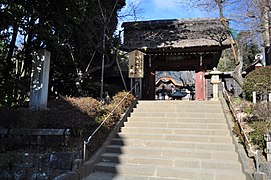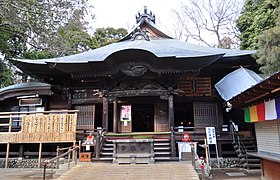Jindai-ji
The Jindai-ji ( Japanese 深 大寺 ) with the Go Fugakuzan ( 浮 嶽山 ) and Shōrakuin ( 昌樂 院 ) is an old temple that belongs to the Tendai direction of Buddhism. It is located in Chofu in Tokyo .
history
The founding of Jindai-ji goes back a long way. The name of the temple points in the context of esoteric Buddhism ( 密 教 Mikkyō ) to the saint of the water Jinja Daiō ( 深 沙 大王 ). According to temple tradition, the daughter of Sato Osaukon (郷 長 右 近) fell in love with a man named Fukuman (福 満) in the area. The mother was against marriage, Fukman prayed to Jinja Daiō, and the mother finally gave in. As a thank you, the daughter is said to have founded the temple in Tempyō 5 (733) to venerate Jinja Daiō there. In the Jōgan era (859-877), the temple is said to have joined the Tendai direction of Buddhism. The main cult figure at present is Amida Buddha.
The attachment
The facility is bordered in the northeast by a semi-circular hill. You climb stairs to the temple and enter it through the temple gate ( 山門 Sammon ; 1 on the map). The original gate was lost in a fire in 1695, and it was rebuilt in the so-called yakui style. After passing the gate you can see the temple bell ( 鐘楼 Shōrō , 4) on the right-hand side and the main hall ( 本 堂 Hondō ; 2) ahead . The main hall was lost in a major fire in the middle of the 19th century and was only rebuilt in the first half of the 20th century. In 2003, the roof was re-covered, with copper plates in the form of tiles being used instead of tiles.
To the left of the main hall, set back a little, is the Gansandaishidō ( 元 三 大師 堂 ; 3), which was popular in the Edo period to ask for luck in life. In 1900, under the hall, a group of sculptures of a seated Shaka Buddha with two companions made of bronze with gold traces ( 金銅 釈 迦 如 来 椅 像 Kongō Shaka Nyorai Izō ) was discovered, for which a separate building, the Shakadō ( 釈 迦 堂 ; 5) was built . The group of sculptures, the Three Hakuhō Buddhas ( 白鳳 三 仏 Hakuhō Sanbutsu), which was initially registered as an Important Cultural Property of Japan , has now received the status of a national treasure .
To the right of the main hall is the monks' quarters with the abbey residence (A) and the guest house "Accommodation for sparrows" ( 雀 の お 宿 Suzume no oyado ; G). In the rear, rising part of the temple area stands the small Kaisandō ( 開山 堂 ; 6), which is dedicated to the temple founder. Even further above and further to the west is the cemetery.
If you leave the temple through a side exit next to the Shakadō, you get a little further above to the hall of the Jinja Daiō ( 深 沙 大王 堂 ), in which it is worshiped as part of esoteric Buddhism.
photos
Remarks
- ↑ Hakuhō ( 白鳳 ) indicates the Hakuhō period, the years from 673 to 686.
literature
- Tokyo-to rekishi kyoiku kenkyukai (Ed.): Jindaiji . In: Tokyo-to no rekishi sampo (ge). Yamakawa Shuppan, 2005, ISBN 978-4-634-24813-7 .
- Saitō Gesshin u. a .: Edo meisho zue ( 江 戸 名 所 図 会 ). Six volumes, 1834 to 1836.
Web links
Coordinates: 35 ° 40 ′ 3.1 ″ N , 139 ° 33 ′ 1.7 ″ E






